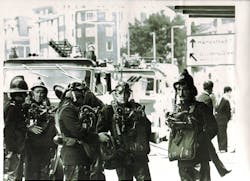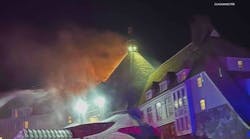When I joined the London Fire Brigade in 1971, I was the youngest operational firefighter they had ever taken on. Back then I could never have possibly imagined what traumas, turmoil, emotional impacts and, in some cases, overriding euphoria lay ahead for me over the next five decades.
Early days—London
In the early 70s, London had 114 fire stations and 7,000 firefighters. It was one of the largest cities in the world with some of the busiest fire stations in Europe, and in terms of “runs and workers,” my station was right up there, responding to nearly 5,000 emergencies every year with around 100 fires requiring additional alarms.
London’s post-war infrastructure was still very much in transition, with tall residential concrete tower blocks replacing streets full of dilapidated two-story buildings. This derelict corner of the city became our firefighting “playground” where we learned a great deal among the 100-year-old dock-side, cast-iron, framed warehouses that occasionally burned and collapsed around us. Firefighting in London back then was regular and it was dangerous, but there was always a strong sense of discipline, camaraderie and teamwork that presented a highly professional image.
War Years—New York
I thought I had seen it all during those early years in London, but in 1975, I was introduced to a different environment in which the firefighters were so overworked that you could see it in their faces. I was fortunate enough to obtain the first of a series of detachments from London to study U.S. firefighting strategy and tactics.
Under the wing of FDNY Deputy Chief Bill Bohner, I found myself responding out of the firehouse on East Tremont Avenue in the 7th Division in the South Bronx. It was here, during several months on assignment in New York, that I met and worked with the firefighters of Engine 45, Ladder 58 and Squad 1, all sharing quarters with Battalion 18. Don Devine, Tony Bonnano, Mario De Salvo, Mike Bradley—these guys and all the others had become hardened in dealing with a constant barrage of work, the likes of which I had never seen before. Their eyes were tired and their faces were weathered due to the never-ending time they spent facing severe fires each night, mainly in very large, crumbling tenement blocks. They called these the “War Years” in New York, and the action was constant, with five or six working fires every night.
By 1976, the busy East Tremont firehouse was recording a number of runs and workers that no other firehouse in the city has ever equalled. In 1976, Engine 45 became New York’s busiest engine company, responding to more than 7,800 calls. Every third night, Engine 45 would exchange with “quieter” companies to gain some relief from the constant bombardment of death and destruction.
I made some good friends there and learned a lot about firefighting, about politics and about myself. I learned that I wanted to be like these firefighters, as they were truly great role models for a young and impressionable rookie—in fire and in life. What impressed me most about my time in the South Bronx was witnessing the kindness and devotion of the firefighters who worked so hard for some good people who were caught up in this poverty trap and treated every person the same whatever their color, creed or religion, all to give everything they could to try and make the residents’ days better and their lives safer and more bearable. And they did so while constantly risking their own lives for the people they served. It was beyond anything else an honor to have known and worked with such high-caliber professionals who were so committed to their role.
A “cross-breed” firefighter
Fighting a room fire with a two-gallon extinguisher was new to me. I had never seen before how effective the simple closing of a room door could be in controlling a fire’s intensity and slowing spread. These simple door-control techniques were well practiced by ladder company firefighters advancing quickly to the fire floor, bringing the fire within the capability of a tiny hose stream being applied with a finger over the nozzle to control the pattern.
Some years later, I was to see the same technique practiced by Spanish firefighters from inside the fire room itself, closing the entry door behind and radioing for the outside vent man (OVM) to create an opening that took the fire toward and out of the far-side window, causing what we now know as a flow-path reversal.
On my return to London, I began to write a series of articles in our national fire journals suggesting that our firefighting approaches would benefit from a more informed and developed approach to venting fire buildings and defined what I saw as a “new wave” strategy that could be used. I entitled the new strategy “tactical ventilation,” creating a middle-of-the-road approach between too much and too little venting of a fire building; this terminology eventually caught on globally, although the actual definition struggled to gain popularity for some 20 years. For reference, tactical ventilation is the containment or venting actions by firefighters, used to take control from the outset of a fire’s burning regime, in an effort to gain tactical advantage during interior structural firefighting operations.
Then during the 1990s, I spent several months on further study detachment from the London Fire Brigade to the fire departments of New York City (Rescue 1), Boston, Chicago, Los Angeles City and County, Seattle, San Francisco, Phoenix, Dallas, and Miami and Metro Dade in Florida. I also spent time in Sweden learning more about their innovative 3D water-fog training techniques using short, controlled bursts of the nozzle, cooling and shrinking hot smoke layers near the ceiling and reducing flashover potential while raising the smoke interface away from the floor.
It was after many months of such detachments that, psychologically, I began a steady transition into a sort of “cross-breed” firefighter. I had so much strategic development going on in my mind, and at this stage of my career, I had begun to form a proactive approach at fires, always one step ahead of the fire and sometimes ahead of my own crew’s actions. (Please understand that this in no way should be considered freelancing.)
If I turned up at an interior door with a large axe or an entry tool already in my hands, this was proactive thinking that many U.S. firefighters take for granted. The firefighters with whom I worked in London were traditionally quite aggressive in their approach to firefighting and nearly always took the hoseline in from the unburned side of a fire building. However, the firefighting deployments were also founded very much on a task force-based reactive approach, countering each development and situation as it arose with a brief time lag of response in between. In contrast, the U.S. style of firefighting was already anticipating and preparing for “trouble” during the moments after arrival on scene.
Changing gears
There was a series of fires in London during the 1980s where we were caught off guard, where the reactive time lag put occupants at risk, where we may have been slow to get water on the fire and where a firefighter died. As a group, my firehouse talked extensively about these events, and our captain decided to evaluate some more proactive tactics on a local basis. We discussed these with the four surrounding firehouses and they agreed to observe and maybe join in.
These approaches included the introduction of Swedish water-fog firefighting tactics, two-person roof-teams to explore carefully coordinated venting actions of stair shafts, and the wider deployment of breathing apparatus at every fire, particularly in the London underground train network (the Tube) and in high-rise buildings. These approaches had some great effect, increasing firefighter and occupant safety and reducing reactive time lags considerably.
Key observations
Having seen so many useful tactics in different areas of the world, I began writing about my experiences in the United States and, in particular, about tactical ventilation, fire behavior, under-ventilated fires, Swedish water-fog tactics, firefighting water flow-rates and air flow-path control.
I hear a lot about evidence-based firefighting and transitional attacks. I find that much of what is written now has always been known and practiced by those who understand fires. The terminology may be new, but the tactics themselves are old, although venting house fires is entirely different than venting cocklofts in tenement buildings, and initiating vent, enter, isolate, search (VEIS) off a fire escape is different than utilizing ladders to undertake the same.
It’s interesting to consider that the issue of tactical ventilation—isolating, containing or venting a fire building to tactical advantage—is exactly what is now being proposed now in the United States, following the research offered by NIST and UL.
I sometimes hear fire officers at conferences extoling the virtues of aggressive interior attack without appreciating how response times, staffing, experience, training and supporting resources might affect these very benefits. In other instances, I recognize that poorly led or inappropriately trained firefighters are at a distinct disadvantage in their tactical approaches. However, there is a vast difference between firefighting in a big city with tall concrete and masonry buildings and effective staffing levels and suburban rural areas where staffing is low, response times are longer and the lack of fire experience is evident although enhanced by training. In these latter environments in particular, evidence-based firefighting makes a whole lot of sense. The takeaway: Don’t get too tied down with the semantics, but get to the critical parts and understand what they mean to you and your strategic set-up.
All these years later, I also researched methods of fire suppression and saw clear advantages of FDNY's high-flow strategy over low-flow/high-pressure attacks commonly used in Europe and elsewhere. Recent research in the United Kingdom has shown that high water flows applied in the first 10 minutes of a fire reduces the damage to the building in the long term. However, wherever we are isolating or containing the fire, we need to take control of the smoke and gases in a better way, and this is where the Swedish tactics can assist us greatly.
It is estimated by my own research that a 20–25-MW fire is probably the largest fire a single 150-gpm handheld hoseline can deal with. Where sprinklers are not installed in such situations, the fire service is quite often helpless in containing such rapid fire growth. Quick water is generally key to a successful outcome, whether that is externally or internally applied. It saves lives and it saves property.
Final thoughts
Looking back, some four decades later, I can clearly see some of the key learning points I took with me from my time in the United States. First, we all have different construction, building layouts, firefighting techniques and tactical approaches. Learning from each other and sharing knowledge across the pond has been a way of making us all better at what we do. Quite simply put, in the words of Chief Forest Reeder: “Better – Faster – Safer – Smarter.”






